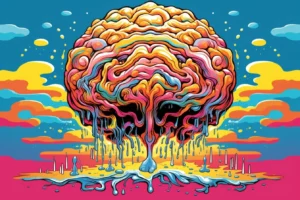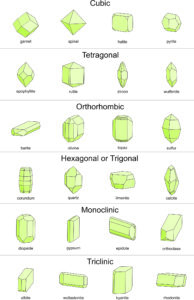 Crystals are not shaped like the Buddha’s face
Crystals are not shaped like the Buddha’s face
When I was in a bachelors psychology class at Sewanee I had to listen to a student, who was a enthusiast of psilocybin mushrooms, go on a rant to the professor about how there were “magic crystals” in the brain. According to him the crystals were “shaped like the buddha’s face” and had been used by “real scientists” to discover things about aliens and mythology. One of these things was that the city of Atlantis, a mythological city that sank, was actually the city of Thebes, a real city in Egypt that is still there. This was accomplished somehow by the use of energy and aliens who spoke to people through the brain crystals. The point of the rant was that the class should vote for Ron Paul, a Libertarian candidate for president at the time. The professor and most of the class were unimpressed.
At the time I thought the idea of crystals in the brain was nuts. I still don’t think that there are buddha faced crystals anywhere. In fact I am still kind of lost about Atlantis, aliens, and Ron Paul also. Ron Paul is still probably the least likely point you will win me over to though. This is why I was shocked a few years ago when I started seeing real legit academic journals validating the idea that there WERE actually crystals, well micro-crystals, in our brain’s pineal gland. I was even more shocked to find out that some respectable people connected them with hypothetical links to hallucinogens, like DMT, and spiritual “energetic” experiences and transcendental awakenings. Weird huh? Is there anything scientific to any of this? Could the candidate who wanted the gold standard be empirically validated by the gold standard of scientific research. Maybe, to that first question but, no, to that last question.
What is the Pineal Gland?

Crystals are not shaped like the Buddha’s face
The pineal gland, a small endocrine gland in the brain, has been a subject of fascination and speculation for centuries, with some attributing it to the seat of the soul or the connection point to spiritual realms. However, its exact role in spiritual experiences is still a topic of ongoing research and debate.
One of the main reasons the pineal gland has been associated with spiritual experiences is its production of melatonin, a hormone that regulates sleep patterns and circadian rhythms. Some believe that the pineal gland is responsible for the production of dimethyltryptamine (DMT), a powerful hallucinogenic substance that has been associated with altered states of consciousness, mystical experiences, and spiritual insights. It has been suggested that the release of DMT could be responsible for mystical experiences or visions that people report during deep meditation, near-death experiences, or certain spiritual practices.
However, the precise role of the pineal gland in spiritual experiences remains a subject of scientific investigation, and many of the claims about its involvement are still speculative. While some studies have suggested a correlation between spiritual experiences and the pineal gland, the exact mechanisms underlying these connections are not fully understood.
Spiritual experiences are complex and multifaceted phenomena that can have various psychological, cultural, and neurological underpinnings. Factors such as personal beliefs, cultural upbringing, emotional states, and neurological activity all play significant roles in shaping spiritual experiences. While the pineal gland may play a part in regulating certain physiological processes that could influence spiritual experiences, it is just one piece of the puzzle, and a comprehensive understanding of spirituality requires consideration of various other factors.
What do the hormones in the pineal gland do?
Melatonin:
Melatonin is a hormone produced by the pineal gland, primarily known for its role in regulating sleep-wake cycles and circadian rhythms. It is released in response to darkness and helps to promote sleep and relaxation.
Some researchers have suggested that melatonin might play a role in spiritual experiences by influencing the sleep-wake cycle and circadian rhythms, which in turn could impact an individual’s mood, cognitive function, and overall well-being. Disruptions in the sleep-wake cycle have been associated with various mental health disorders, and a well-regulated cycle is thought to contribute to emotional stability and overall spiritual well-being.
Circadian Rhythm Regulation:
Melatonin is involved in the regulation of the body’s internal clock, helping to synchronize the sleep-wake cycle with the natural light-dark cycle. The pineal gland begins to release melatonin in the evening, signaling to the body that it is time to prepare for sleep. This increase in melatonin levels induces drowsiness and helps to promote a restful and restorative sleep.
Sleep Quality Enhancement:
Melatonin not only helps in initiating sleep but also contributes to the quality and duration of sleep. It has been used as a supplement to manage sleep disorders such as insomnia and jet lag. By improving sleep efficiency and promoting a deeper, more restful sleep, melatonin plays a vital role in ensuring overall well-being and optimal cognitive function.
Antioxidant Properties:
Melatonin has been found to exhibit potent antioxidant properties, which may help protect cells from oxidative stress and reduce the risk of certain chronic diseases. Its role as an antioxidant has implications for promoting overall health and supporting various physiological functions, including immune system regulation and neuroprotection.
DMT:
DMT is a powerful hallucinogenic compound that is naturally produced in the human body, including the pineal gland. It has been associated with altered states of consciousness, vivid hallucinations, and profound spiritual experiences.
Many individuals report experiencing intense spiritual insights, mystical experiences, and a sense of connection to higher realms or a divine presence while under the influence of DMT. Some cultures and spiritual practices use DMT-containing plants in ceremonial rituals to induce transcendent experiences and facilitate spiritual growth and understanding.
In the context of spirituality and higher levels of functioning, both melatonin and DMT are believed to influence consciousness and emotional well-being. While melatonin contributes to the regulation of sleep patterns and mood, DMT is associated with altered states of consciousness and spiritual insights. These compounds, along with the intricate workings of the brain and the complex interplay of neurotransmitters and hormones, continue to be the focus of scientific investigation in the realm of consciousness studies and spiritual experiences.
There is still ongoing research into the exact reasons and functions of endogenous DMT (N,N-Dimethyltryptamine) in the human brain, and its precise role is not fully understood. However, some theories suggest that DMT might play a role in various normal physiological functions, and its presence may not necessarily be related to inducing hallucinations. Here are some possible explanations:
Neurotransmitter Regulation:
Some researchers propose that DMT may function as a neurotransmitter or neuromodulator in the brain, influencing various cognitive and emotional processes. It might be involved in regulating mood, memory, and other cognitive functions. In this context, its role is not primarily to induce hallucinatory experiences but to modulate normal brain functions.
Neuroprotective Properties:
Studies suggest that DMT might have neuroprotective properties, potentially protecting the brain from certain types of damage. Research in this area indicates that DMT could play a role in promoting neuronal survival and resilience, thereby supporting overall brain health and function.
Natural Regulatory Role:
Some scientists propose that endogenous DMT might have a natural regulatory role in the brain, helping to maintain homeostasis and balance within the central nervous system. It might contribute to the regulation of various physiological processes, ensuring the smooth functioning of different brain regions and systems.
Are their Really Consciousness Crystals in the Pineal Gland?
Yes there really are micro crystals in the pineal, but there is debate about what they do. Biomineralization refers to the process by which living organisms produce minerals, often within specialized tissues. Some researchers have proposed that the pineal gland might undergo specific biomineralization processes that lead to the formation of microcalcite or magnetite crystals. Researchers have employed microscopic techniques, such as light microscopy or electron microscopy, to examine tissue samples from the pineal gland and identified the presence of crystalline structures consistent with calcite. Chemical analysis, such as spectroscopy or X-ray diffraction, has been utilized to determine the composition of the crystalline structures found in the pineal gland and confirm whether they are indeed composed of calcite.
The theories regarding the hypothetical functions of calcite crystals in the human pineal gland remain largely speculative, and the available evidence supporting these claims is limited and often indirect. While some studies have explored the presence of calcite crystals in the pineal gland and their potential roles, the concrete evidence for each proposed function is still not firmly established. Here is a brief overview of the available evidence for each of the suggested functions:
Piezoelectricity:
Some studies have demonstrated the presence of calcite microcrystals in the human pineal gland using various imaging techniques. However, the direct evidence linking these crystals to the generation of electrical signals or piezoelectric activity within the pineal gland is scarce. Further research is needed to elucidate the precise role of these crystals in generating electrical potentials and their potential impact on pineal gland function.
Light Sensitivity:
While the pineal gland is primarily known for its role in regulating circadian rhythms and producing melatonin in response to light and dark cycles, the direct link between calcite crystals and light sensitivity in the pineal gland remains largely speculative. Some research has suggested that certain animals possess rudimentary light-sensing capabilities in the pineal gland, but the evidence for a similar mechanism in humans is not well-established.
Biomineralization
Regulation: Studies have identified the presence of calcite crystals in the pineal gland, but their exact role in the regulation of biomineralization processes within the gland is not fully understood. While some research has indicated that the calcite crystals may be involved in dynamic mineralization processes, further investigations are necessary to determine the precise mechanisms through which these crystals influence pineal gland function.
Magnetoreception:
The hypothesis that calcite crystals in the pineal gland might be associated with magnetoreception in humans is primarily based on analogies with certain animal species that demonstrate magnetic sensitivity. However, the direct evidence for magnetoreception in humans, as well as the specific role of calcite crystals in facilitating this function, is still a topic of ongoing research and debate.
While some studies have identified the presence of calcite crystals in the human pineal gland, the available evidence for their proposed functions is limited, and further research is required to validate these hypotheses. The complex nature of the pineal gland and the multifaceted processes involved in its regulation necessitate a comprehensive approach integrating various scientific disciplines to elucidate the role of calcite crystals, if any, in the function of this enigmatic organ.
What are the wildest theories about the microcrystals in the pineal gland?
The hypothetical suggestion that crystals, such as piezoelectric crystals, in the brain could react to external waves or frequencies remains a topic of speculation and has not been established by scientific evidence. However, some speculative theories propose that if such crystals were present and capable of interacting with external waves or frequencies, they might influence brain function in the following ways:
Electromagnetic Field Interaction:
Some theories suggest that if the crystals in the brain were responsive to external electromagnetic fields or frequencies, they could potentially modulate neural activity and information processing. The interaction between these crystals and external electromagnetic waves might affect neuronal firing patterns and synaptic transmission, thereby influencing cognitive processes and sensory perception.
Resonance Effects:
Speculative hypotheses propose that the crystals, if sensitive to specific frequencies or resonance patterns, could resonate with external waves or frequencies, leading to the amplification or modulation of neural signals. This resonance effect might impact the synchronization of neural oscillations and the coordination of brain activity, potentially influencing cognitive states and consciousness.
Information Encoding and Decoding:
Some speculative theories suggest that the crystals could function as transducers, converting external wave signals into neural information or vice versa. This hypothetical mechanism might enable the brain to perceive and interpret external stimuli or transmit neural signals to the external environment, potentially influencing sensory perception, cognitive processing, and behavioral responses.
Yeah but what are the most nonscientific, weird, and even wilder theories out there about the pineal gland?

We removed the tumor from your brain sir!
Interdimensional Gateway Hypothesis:
This speculative theory suggests that the pineal gland, housing microcrystals with piezoelectric properties, serves as a gateway to interdimensional realms or parallel universes. According to this concept, the activation of these crystals through specific practices or stimuli could facilitate the perception of alternate dimensions or realities beyond the scope of ordinary human consciousness.
Telepathic Transceiver Theory:
Some proponents of this theory propose that the microcrystals within the pineal gland act as transceivers capable of sending and receiving telepathic signals. It is speculated that the piezoelectric properties of these crystals enable the amplification and transmission of neural signals, facilitating telepathic communication between individuals or even enabling communication with sentient beings from other planets or dimensions.
Consciousness Amplification Hypothesis:
This theory suggests that the piezoelectric microcrystals in the pineal gland can amplify and enhance consciousness, leading to heightened awareness, spiritual enlightenment, and even the development of psychic abilities. Proponents of this idea speculate that the activation of these crystals through specific techniques or external stimuli could unlock latent human potential, leading to expanded states of awareness and perception.
Ancient Knowledge Storage Concept:
Some speculative theories propose that the microcrystals in the pineal gland serve as repositories for ancient or esoteric knowledge, accumulated over generations and encoded within the crystalline structures. According to this idea, the activation or manipulation of these crystals could potentially unlock hidden knowledge, enabling individuals to access profound wisdom or insights from ancient civilizations or advanced extraterrestrial beings.
Where on the pineal spectrum of belief do you fall?
Did you enjoy this article? Checkout the podcast here: https://gettherapybirmingham.podbean.com/
Jungian Topics
How Psychotherapy Lost its Way
Therapy, Mysticism and Spirituality?
What Can the Origins of Religion Teach us about Psychology
The Major Influences from Philosophy and Religions on Carl Jung
Bibliography:
- Baconnier, S., Lang, S. B., & De Seze, R. (2002). Calcite microcrystals in the pineal gland of the human brain: first physical and chemical studies. Bioelectromagnetics, 23(7), 488-495.
- Bókkon, I., Salari, V., Tuszynski, J. A., & Antal, I. (2010). Estimation of the number of biophotons involved in the visual perception of a single-object image: Biophoton intensity can be considerably higher inside cells than outside. Journal of Photochemistry and Photobiology B: Biology, 100(3), 160-166.
- Nichols, D. E. (2018). N, N-dimethyltryptamine (DMT): an endogenous hallucinogen and potential therapeutic agent. Frontiers in Neuroscience, 12, 536.
- Nichols, D. E., Johnson, M. W., & Nichols, C. D. (2017). Psychedelics as medicines: an emerging new paradigm. Clinical Pharmacology & Therapeutics, 101(2), 209-219.
- Strassman, R. (2001). DMT: The spirit molecule: A doctor’s revolutionary research into the biology of near-death and mystical experiences. Simon and Schuster.
Continued Reading:
- Barker, S. A. (2018). N, N-Dimethyltryptamine (DMT), an endogenous hallucinogen: past, present, and future research to determine its role and function. Frontiers in Neuroscience, 12, 536.
- Carhart-Harris, R. L., & Goodwin, G. M. (2017). The therapeutic potential of psychedelic drugs: past, present, and future. Neuropsychopharmacology, 42(11), 2105-2113.
- Nichols, D. E. (2016). Psychedelics. Pharmacological Reviews, 68(2), 264-355.
- Revonsuo, A., Kallio, S., & Sikka, P. (2009). What is an altered state of consciousness?. Philosophical Psychology, 22(2), 187-204.
- Winkelman, M. J. (2018). An ontology of psychedelic entity experiences in evolutionary psychology and neurophenomenology. Journal of Psychedelic Studies, 2(1), 5-23.



























0 Comments